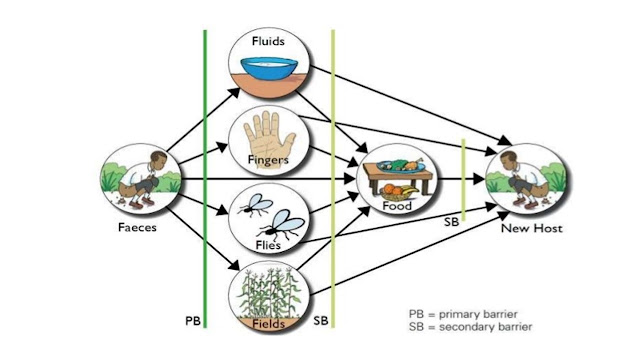Spotters in "Environment and Health: Sanitation" for CFM & MPH students
1. Sanitation Barrier:
Important points:
- Disease agents transmitted to a new host through various channels: 1. water/ fluids, 2. fingers, 3. flies, 4. soil, and 5. food
- The disease cycle may be broken at various levels: 1. protection of water, 2. personal hygiene, 3. control of flies, 4. segregation of faeces, and 5. protection of foods
- The most effective step would be to segregate the faeces & arrange for proper disposal so that the disease agent cannot reach the new host, directly or indirectly.
- The segregation of the excreta by imposing a barrier called the " sanitation barrier" which can be provided by a 'sanitary latrine' and disposal pit.
- It was first introduced by the Rockefeller foundation during 1930s in campaigns of hookworm control.
- It consists of a circular hole of 30-40 cm (12-16 in.) in diameter.
- Dug vertically into the ground to a depth of 4 to 8 m (13-26 ft.), most commonly 6 m (20 ft.).
- Auger is needed to dig a borehole.
- The hole is lined with bamboo matting or earthen-ware rings to prevent caving in of the soil, especially in loose & sandy soils.
- A concrete squatting plate is placed over the hole.
- It serves well for over one year for a family of 5 or 6 people.
- A family-type installation, not recommended for public convenience.
- When contents reach within 50 cm (20 in.) of the ground level, the squatting plate is removed & the hole is closed.
- Merits: 1. No need for daily removal of nightsoil, hence sweeper not needed, 2. The pit is unsuitable for fly breeding, 3. No danger of water pollution if located 15 m (50 ft.) away from a water source.
- Demerits: 1. fill up rapidly, 2. Auger is required to dig, 3. In places where subsoil water is high, it may be difficult to dig more than 3 m (10 ft.).
- It was first introduced in Singur, West Bengal in 1949-1950.
- An improvement over borehole latrine.
- A circular pit of about 75 cm (30 in.) in diameter & 3 to 3.5 m (10-12 ft.) deep dug into the ground.
- In sandy soil, depth may be reduced to 1.5-2 m(6-7 ft.)
- The pit may be lined with pottery rings & a concrete squatting plate is placed at the pit.
- Merits: 1. Easy to construct, 2. Has longer life, 3. A pit of 75 cm (30in. ) diameter & 3-3.5 m (10-12 ft.) deep will let for about 5 years for a family of 4-5 persons.
- Here, the squatting plate is fitted with a 'water seal- a small depth of water contained in a bent pipe called the trap'.
- Water seal performs two important functions: 1. It prevents access to flies, 2. It prevents the escape of odours & foul gases.
- Two types of water seal latrines have gained recognition for wide use: 1. The P.R.A.I. types, evolved by the Planning, Research & Action Institute, Lucknow (U.P), 2. The RCA type, designed by the Research-cum-Action projects in Environmental sanitation of the Ministry of Health, GOI.
5. Septic tank:
A single-chambered septic tank found satisfactory for small installations.
Design: 1. Capacity- a minimum of 500 gallons, 2.Lenth- twice the breath, 3. Depth- 1.5-2 m, 4. Liquid depth- 1.2 m, 5. Air space depth-30 cm, 6. Ideal retention period-24 hours.
Anaerobic digestion- takes place in a septic tank proper.
Aerobic oxidation: takes place in sub-soil (outside the septic tank)
Process of purification:
- Solids settle down in the tank & form 'sludge' whereas lighter solids (including grease & fat) rise to the surface to form 'scum'. Solids undergo anaerobic digestion, methane gas is formed.
- Liquid which passes out of outlet pipe is called ' Effluent'(it contains bacteria, cysts, helminthic ova & organic matter) which is allowed to percolate in sub-soil & it undergoes aerobic digestion by bacteria.
Operation & maintenance:
-Avoid soap and disinfectants
-Desludging once in a year
-New tanks to be filled with water & seeded with ripe sludge from another septic tank.
Important points:
6. Aqua privy:
Important points:
- It functions like a septic tank.
- The shape may be circular or rectangular.
- A capacity of 35 cu. ft. is recommended for a small family, allowing >6 years for cleaning purposes.
7. Sewage Treatment Plant:
- Modern sewage treatment plants are based on biological principles of sewage purification, where the purification is brought about by the action of anaerobic and aerobic bacteria.
- The treatment of sewage may be divided into two stages, primary treatment and secondary treatment.
- In primary treatment, the solids are separated from the sewage partly by screening and partly by sedimentation and subjected to anaerobic digestion which is the first stage in purification;
- In secondary treatment, the effluent is subjected to aerobic oxidation, which is the second stage in purification.
References:
- Park, K. (2019). Park's textbook of preventive and social medicine. 25th. Jabalpur, India: M/S Banarsidas Bhanot.
- Kadri AM. (2019). IAPSM's Textbook of Community Medicine. 1st. New Delhi, India: Jaypee Brothers Medical Publishers (P) Ltd.
- https://www.slideshare.net/HemantKumar98/sanitation-barriers photo credit
- https://repository.lboro.ac.uk/articles/Borehole_latrine/7907729 photo credit
- https://en.wikipedia.org/wiki/Pit_latrine photo credit
- http://helid.digicollection.org/en/d/Jh0210e/3.3.6.html photo credit
- https://www.open.edu/openlearncreate/mod/oucontent/view.php?id=80510§ion=8.1 photo credit
- http://repo.floodalliance.net/jspui/bitstream/44111/1778/1/4f7ceecd-e1a0-4b9a-a491-05dd1661b3dc%20(1).pdf photo credit











Hey what a brilliant post I have come across and believe me I have been searching out for this similar kind of post for past a week and hardly came across this. Thank you very much and will look for more postings from you best Home Insulation Plano Texas service provider.
ReplyDelete